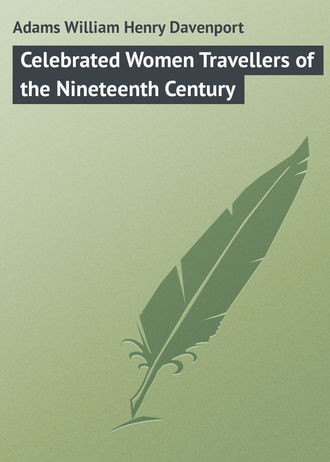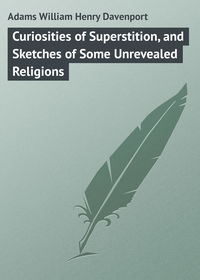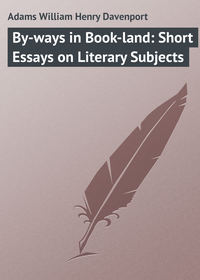 полная версия
полная версияCelebrated Women Travellers of the Nineteenth Century
Lady Barker is a practised writer, and a good deal of literary skill is shown in her books of travel, "Station Life in New Zealand" and "A Year's Housekeeping in South Africa." Pleasanter reading one could hardly wish for; the sketches are vivid, and the observations judicious; the style is fluent, and flavoured by a genial and unobtrusive humour. Lady Barker looks at things, of course, with a woman's eye, and this womanliness is one of the charms of her books. She sees so much that no man would ever have seen, and sees it all in a light so different from that in which men would have seen it. To our knowledge of South Africa, Lady Barker has unquestionably made a very real and interesting contribution. She and her husband, who had been appointed to an official position of importance in Natal, arrived at Cape Town in October, 1875, and, after a brief rest, steamed along the coast to the little port of East London. Thence they proceeded to Port Durban, where they disembarked, and, in waggons drawn by mules, jolted over the fifty-two miles that lie between Port Durban and their place of destination, Maritzburg. During her residence there she made good use of her time and opportunities, studying the native ways and usages, sketching Zulus and Kaffirs, interviewing witches and witch-finders, exploring the scenery of the interior, and accomplishing an expedition into the Bush, the result being a book of some 320 pages, in which not one is dull or unreadable. Of her lightness and firmness of touch we can give but one specimen, a sketch of a Kaffir bride: —
"She was exceedingly smart, and had one of the prettiest faces imaginable. The regular features, oval face, dazzling teeth, and charming expression, were not a bit disfigured by her jet-black skin. Her hair was drawn straight up from her head like a tiara, stained red, and ornamented with a profusion of bone skewers, a tuft of feathers being stuck coquettishly over one ear, and a band of bead embroidery, studded with brass-headed nails, worn like a fillet where the hair grew low on the forehead. She had a kilt, or series of aprons rather, of lynx skins, a sort of bodice of calf-skin, and over her shoulders, arranged with ineffable grace, a gay table-cover. Then there were strings of beads on her pretty, shapely throat and arms, and a bright scarlet ribbon tied tightly round each ankle. All the rest of the party seemed immensely proud of this young person, and were very anxious to put her forward in every way. Indeed, all the other women, mostly hard-working, hard-featured matrons, prematurely aged, took no more part in the visit than the chorus of a Greek play, always excepting the old luduna, or headman of the village, who came as escort, and in charge of the whole party. This was a most garrulous and amusing individual, full of reminiscences and anecdotes of his fighting days. He was rather more frank than most warriors, who 'shoulder their crutch, and show how fields are won;' for the usual end of his battle stories was the naïve confession, 'and then I thought I should be killed, and so I ran away.' He and I used up a great many interpreters in the course of the visit; for he wearied every one out, and nothing made him so angry as any attempt to condense his conversation in translating it to me. But he was great fun; polite as became an old soldier, full of compliments and assurances that 'now the happiest day of his life having come, he desired to live no longer, but was ready for death.' The visit took place on the shady side of the verandah, and thither I brought a large musical box and set it down on the ground to play. Never was there such a success. In a moment they were all down on their knees before it listening with rapt delight, the old man telling them the music was caused by very little people inside the box, who were obliged to do exactly as I bade them. They were in a perfect ecstasy of delight for ever so long, retreating rapidly, however, to a distance whenever I wound it up. The old luduna took snuff copiously all the time, and made me affectionate speeches, which resulted in the gift of an old great coat, which he assured me he never would live to wear out, because he was quite in a hurry to die and go to the white man's land now that he had seen me."48
Of all the European countries, Hungary, we think, is the one least represented in our English literature of travel, though to Englishmen it might seem to have peculiar attractions, in virtue of its romantic scenery, its historical associations, and the brave, independent, and vigorous character of its inhabitants. "Its history is that of Greece," says a German writer; "the same heroism lives within its borders, the names of its heroes alone have changed." We turn, therefore, with interest, while writing these last pages, to "Magyarland," a lady's "Narrative of Travels through the Highlands and Lowlands of Hungary." She entered Hungary on the side of its majestic Aljöla, or plains, which extend over an area of 5,400 square miles, and in some places are inhospitable sandy wastes; in some, highly cultivated; in others, green and flowery pastures, where large herds of horses and cattle roam unfettered. These plains are inhabited by various races – the Magyars, who are the dominant people; the Wallachs, who dwell in the easternmost districts; the Germans, Saxons, and Shecklers. South-west of the Carpathians live the Slovaks; in Croatia and Servia the Croat Serbs; and in the provinces south-east of the Carpathians are the Rusniaks or Ruthenians. About these races, and their manners and customs – about Buda-Pesth and Semlin, and the ice-caves of the snowy Tabree, and the wines of Tokay, and the scenery of Romania, our authoress has much to say with equal liveliness and grace.
1
A pseudonym derived from the ancient name of the Danube – Ister.
2
The chief of which are: "La Vie Monastique dans l'Eglise Orientale," 1855; "La Suisse Allemande," 1856; "Les Héros de la Roumanie;" "Les Roumains et la Papauté" (in Italian); "Excursions en Roumélie et en Morée," 1863; "Les Femmes de l'Orient," 1858; "Les Femmes d'Occident;" "Les Femmes, par une Femme," 1865.
3
See the princess's "La Suisse Allemande et l'Ascension du Mönch." 4 vols., 1856.
4
George Eliot.
5
A verst is equal to 3,500 feet.
6
Except when broken by the war of 1855.
7
A. W. Kinglake: "Invasion of the Crimea," Vol. i., c. 1, 6th edition.
8
See Carlyle's "Biographical Essays, § Diamond Necklace;" also, H. Vizetelly's "True Story of the Diamond Necklace."
9
F. Milon: "Life and Letters of Frederika Bremer" (Ed. 1868), p. 9.
10
Besides the works named in the preceding pages, Frederika Bremer wrote "The Diary," "Life in Dalecarlia," "Brothers and Sisters," and "The Midnight Sun."
11
Frederika Bremer's judgment is certainly at fault here; and in other points she does not show a very exact discrimination. The sketch, indeed, is witty rather than accurate; a clever caricature rather than a correct drawing.
12
There is much more poetry in Miss Bremer's prose works than in her poems, which are little more than the efforts of an accomplished versifier.
13
F. Bremer, "Two Years in Switzerland and Italy" (transl. by Mary Howitt), i. 15-17.
14
One or two quotations, illustrative of Frederika Bremer's style, we may give in a note. And, first, her impression of the mountains ("Two Years in Switzerland and Italy," i. 239): —
"They stand in nature like the prophets of the Old Testament, or, more correctly speaking, like the old wise men and teachers of the pagan world, and point us to a greatness high above that in which we, the children of the valleys and the plains, have our being. For these pyramids are not the pleasantest things upon earth, they are not the fragrance of the flowers, not the singing of the birds, not the changing life of the seasons. Imperishable in their eternal place, they are moved alone by the sun. The sun alone causes them to glow or become pale, and to paint for us images of life or of death. But they alone receive its earliest beams in the morning, and retain its light in the evening long after it has departed from us. It is in their bosoms that spring feeds the great rivers which fertilize the earth, foster the life of cities, and extend themselves, beautifying, benefiting, even to the smallest blades of grass."
And, secondly, the Simplon (ibid. i. 315, 316): —
"The scenery was wild, and of an imposing grandeur. The sun shone upon the mass of cloud, and wind chased the misty shadows amongst the mountains. All around, in an immense circle, glaciers and snow-clad mountain-peaks gleamed forth from amongst the clouds. Before me rose a lofty mountain, shaped like a cupola, the top of which was covered with a black cloud, whilst the lower part was lighted up by bright sunshine. It was the peak of the Simplon. Troops of misty shapes were chased round it by the wind, as in a wild sweep, whilst they strove to reach the top, which seemed in its turn to reject them. The black cloud lay threateningly above, and the white, misty spectres careered around like the unhappy and unsettled souls in the Hell of Dante. Still increasing in number, they ascended from the depth below; still more and more wildly were they chased round the ice-clad mountain – clad as in tatters of ice – into the dazzling sunshine beneath the black forbidding cloud. Masses of water were hurled down from the neighbouring glaciers with thundering din. There is danger here from avalanches during spring and autumn, and for that reason strong stone galleries are built in many parts of the road to serve as a shelter for people and for carriages. Avalanches and torrents are hurled down over the arched roofs and into the abyss on the other side. Even now masses of ice hang threateningly upon the heights to the left along the road; but these will dissolve in foaming rivers, which will find their outlets in deep clefts of the mountain, over which the road is carried, or they are conveyed away by means of strongly constructed gutters over the roofs of the stone galleries. One of these streams is hurled down with a force and a din which is deafening. The whole of this scene was so wild and so magnificent that it thrilled me at once with terror and joy. The sun gleamed through all as with lightning-flashes, and as if in combat with the demons of nature."
15
"Greece and the Greeks," i. 40, 41.
16
A monument has since been erected.
17
The story of Miss Tinné's death is differently told by different authorities; but we believe the above to be a correct version. See Dr. Heughlin's "Reise in das Gebiet des Weissen Nil," etc.; Dr. Augustus Petermann, "Mittheilungen;" Miss Edwards's "Six Life-Studies of Famous Women," etc.
18
Humboldt: "Ansichten der Natur," i. 8.
19
Thomas Carlyle: "Lectures on Heroes," Lect. iii.
20
"Eöthen," pp. 87, 88.
21
Alphonse de Lamartine: "Voyage en Orient." Lamartine's version of Lady Hester's conversation is sometimes of dubious accuracy.
22
"Eöthen," pp. 81, 82. In the following narrative we very frequently adopt, with slight alteration and condensation, Mr. Kinglake's language.
23
The branch which obtains Æneas admission to the shades (Æneid, Book vi.) —
"This branch at least" – and here she showedThe branch within her raiment stowed —"You needs must own"…He answers not, but eyes the sheenOf the blest bough.24
"Eöthen," pp. 97, 98.
25
"Memoirs of Lady Hester Stanhope," i. 135, 136.
26
"Memoirs of Lady Hester Stanhope," i. 142-144.
27
"Memoirs of Lady Hester Stanhope," iii. 189, 190.
28
Lady Brassey: "A Voyage in the Sunbeam," pp. 46, 47.
29
Lady Brassey: "A Voyage in the Sunbeam," p. 90.
30
Lady Brassey: "A Voyage in the Sunbeam," pp. 110, 122.
31
Lady Brassey: "A Voyage in the Sunbeam," pp. 129, 130.
32
Lady Brassey: "A Voyage in the Sunbeam," pp. 227, 228.
33
Lady Brassey: "Voyage of the Sunbeam," pp. 256-262.
34
Lady Brassey: "A Voyage in the Sunbeam," pp. 268-272.
35
Lady Brassey: "A Voyage in the Sunbeam," pp. 309-312. With this Japanese bill of fare we may contrast a Chinese bill of fare which Lady Brassey preserves: —
Four courses of small bowls, one to each guest, viz. – Bird's-nest Soup, Pigeon's Eggs, Ice Fungus (said to grow on ice), Shark's Fins (chopped).
Eight large bowls, viz. – Stewed Shark's Fins, Fine Shell Fish, Mandarin Bird's Nest, Canton Fish Maw, Fish Brain, Meat Balls with Rock Fungus, Pigeons stewed with Wai Shau (a strengthening herb), Stewed Mushroom.
Four dishes, viz. – Sliced Ham, Roast Mutton, Fowls, Roast Sucking Pig.
One large dish, viz. – Boiled Rock Fish.
Eight small bowls, viz. – Stewed Pig's Palate, Minced Quails, Stewed Fungus, Sinews of the Whale Fish, Rolled Roast Fowl, Sliced Seals, Stewed Duck's Paws, Peas Stewed.
36
Lady Brassey: "Sunshine and Storm in the East," pp. 41-44.
37
Lady Brassey: "Sunshine and Storm in the East," p. 431.
38
We have omitted from our list "The Blue Belles of England" (1841); "Tremordyn Cliff" (1838); "Charles Chesterfield" (1841); "The Ward of Thorpe-Combe" (1842); "Young Love" (1844); "Petticoat Government" (1852); and "The Life and Adventures of a Clever Woman" (1853). Between the last-named and "The Vicar of Wrexhill" the gulf is very wide. One cannot help admiring, however, the indefatigable perseverance and the astonishing fertility of this accomplished novelist.
39
Harriet Martineau: "Eastern Life," ii., 81, 82.
40
Harriet Martineau; "Eastern Life," ii. 162-165.
41
Bird: "A Lady's Life in the Rocky Mountains," pp. 89, 90.
42
Isabella Bird: "A Lady's Life in the Rocky Mountains," pp. 108, 109.
43
I. L. Bird: "A Lady's Life in the Rocky Mountains," pp. 194-196.
44
Lady Florence Dixie: "Across Patagonia," pp. 26-28.
45
C. F. Gordon Cumming: "A Lady's Cruise in a French Man-of-war," ii. 38, 39.
46
C. F. Gordon Cumming: "A Lady's Cruise in a French Man-of-War," ii. 177-181.
47
F. and R. Hill: "What We Saw in Australia," pp. 321, 322.
48
Lady Barker: "A Year's Housekeeping in South Africa," pp. 312-314.





